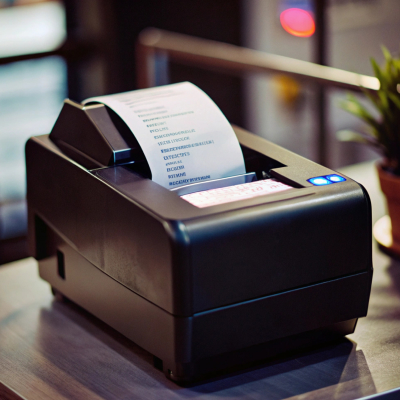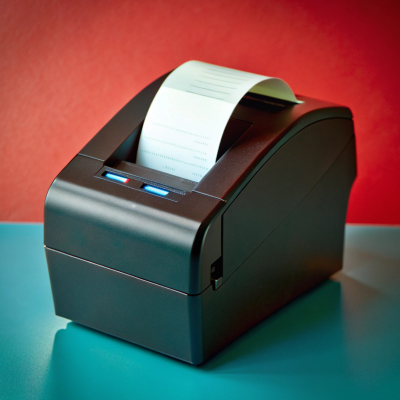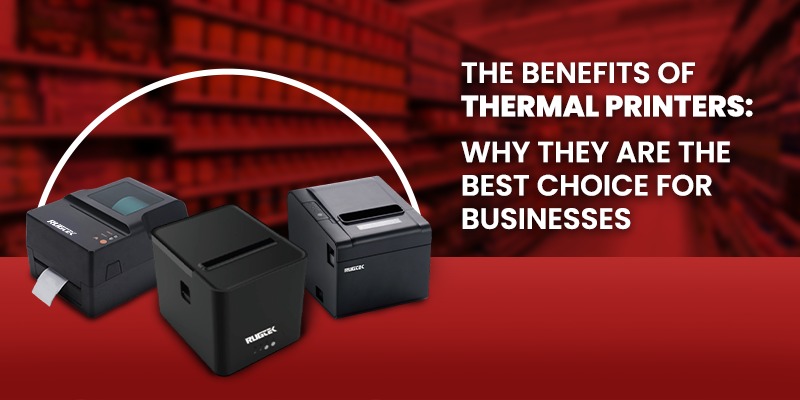Thermal Printers
Thermal printers utilize heat to put the ink on the paper or heat-sensitive paper to develop the image or text on paper. They can be categorized mainly into two types. The first type includes direct thermal, which is based on heat-sensitive paper, and the other is thermal transfer, where the ribbon transfers the ink on the paper.

How Do Thermal Printers Improve Businesses?
The application of thermal printer technology has facilitated the improvement of business organizations in various aspects including efficiency, costs, and value addition to customers. These are some of the ways in which thermal printers contribute to business growth:
Cost Efficiency: Thermal printers do not use ink or toner cartridges, so perpetual printing costs are omitted. One of the major advantages of thermal printing technology is that it makes the operations cost significantly cheaper for the industries that require frequent printing (like marketers and supply chain merchants).
Speed and Efficiency: The convenience of the thermal printer is that it also operates at the fastest speed as compared to other printers. Businesses will also become productive and be able to print receipts, invoices, labels, or tickets as soon as possible with thermal printers. Thus, a thermal printer for business efficiency is the best choice.
Reliability and Durability: Such printers are highly reliable since there will be no technical error that will arise in thermal printers when coping with fast-paced environments.
Sustainability: Thermal printers do not use ink from toner cartridges but heat-sensitive papers instead. For that reason, it remains consistent with the best modern practices of generating better solutions for the business world.
Functionality: Thermal printers can be used at any level like retail and logistics tiers for receipts and carriers, health care department for patient identification wristbands, etc. Its versatility is one of the major advantages of thermal printing technology. For this reason, thermal printing technology is considered to be one of the most fitting for use, mainly due to its flexibility.
Why Choose Thermal Printers Over Other Types Of Printers

Some of the benefits they provide are uniquely different. Thermal printers offers unique approaches for those businesses that are motivated by speed, durability, and cost. These are some of the advantages of thermal printing technology:
Lower Operational Costs: One of the biggest advantages of thermal printing technology is that they do not use ink, toner, or a ribbon which may be very expensive and as a result, they often develop a tendency of having an ink shortage. This can therefore be very efficient in the long run especially where so much business is transacted.
Faster Printing Speed: The reason that makes the use of thermal printers for business efficiency appropriate is that it has fast print speed which will be useful in organizations with high demand for output like retail and logistical industries as well as in ticketing.
Low Maintenance: Unlike paper printers and other types of printers, thermal printers present fewer problems that arise as a result of breakdown or other reasons for service, and therefore thermal printers need fewer service calls.
Compact Design: It is usually compact and lightweight in general for it can be suited to a business organization with limited space such as a shop, mobile business, or kiosk.
High-Quality Prints: Thermal prints are very clear and neat, and the image and text quality are very good, which is suitable when one wants to produce items such as receipts, labels, barcodes, tickets, etc., where the print is very important. This kind of print does not wash or fade away with time because thermal print media is not similar to ink used in inkjet and laser prints.
Durability and Reliability: Thermal printers for business efficiency are built sturdy to withstand the harsh working environments common in manufacturing industries, huge warehouse storage, and outdoor environments. As for thermal printers, there are no problems such as spillage of ink or jamming of papers, which is common with most printers.
Eco-Friendly: The biggest strength of a thermal printer is that it doesn’t have a waste like that of ink or toner cartridges. Most of them incorporate reusable thermal paper, and this makes them more eco-friendly in comparison to most printer types.
Silent Printing: Thermal printers are very quiet during printing compared to other types of printers. Thus, they are more suitable for usage aimed at minimizing noise.
Security: It is most commonly used when a high level of security is needed in an operation. For example, when printing tickets or receipts accompanied with identifiers or barcodes. Heat transfer prints offer quality that eliminates the chances of tampering or counterfeiting.
Rugtek’s Thermal Printers
RP 76 – IV

RP 76 – IV uses a USB interface which makes it very easy to use. It weighs less since its weight is only 2.35 kg. It has a resolution of 203 dpi and a printing speed of 127mm/sec.
RP 82A Compact

With a printing speed of 200mm/s, RP 82A Compact provides a seamless printing experience. It has a resolution of 203 dpi. It does not occupy too much space and is compatible with a wide variety of operating systems. It provides a long-term performance due to the presence of auto-cutter and extensive memory.
RP 326 USE

RP 326 USE is perfect for hospitality and retail industries because it makes transaction processing seamless. You don’t have to worry about paper-end detection issues with RP 326 USE. It comes with a printing speed of 250mm/s and is an amazing option if you are looking at buying thermal printers that perform well.
Conclusion:
Thermal printers for business efficiency are one of the best technologies that are used to print. They are cost-effective for those requiring fast printing technology. They are designed for markets where large numbers of small prints are made, and in the long run, they are cheap compared to other print technologies such as inkjet or laser. Rugtek has some of the best thermal printers for business efficiency.


